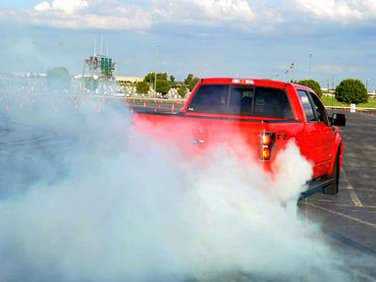Recent Articles
Popular Makes
Body Types
Blue Smoke vs. Black Smoke | Car Trouble

When a vehicle is emitting blue or black smoke, chances are that it is not properly tuned or maintained. When a vehicle is poorly tuned or maintained, the equipment on the vehicle designed to control the level of pollutant emissions may not function properly. Smoke from petrol engine vehicles is mainly due to excessive wear. Diesel vehicles may emit smoke from poor injector maintenance, excessive fuel delivery rates or poor driving technique. The following problems may be the cause of smoke from a vehicle.
Smoke From Gas Engines
Gas engines may emit blue smoke or black smoke. Blue smoke normally means engine wear or damage. Black smoke results from an excessively rich fuel mixture. Where this occurs, the following components may be at fault: • A rich mixture can be caused by excessive build-up of dirt or oil. Replace the filter regularly. • Carburetor and engine management system problems: • choke butterfly unable to open fully • carburetor flooding • incorrect grade of oil • incorrectly adjusted or faulty automatic choke • air cleaner winter/summer lever set in wrong position • manual choke operated incorrectly or when the engine is warm • worn or loose jets or needles • sticking diaphragm • faulty engine management system • faulty oxygen sensor or other engine management sensors • faulty fuel injector

Smoke From Two-Stroke Engines
Two-stroke engines may emit a light blue haze from the exhaust pipe due to oil in the inlet charge. Excessive smoke from two-strokes is usually the result of excessive oil in the inlet charge. Where fuel and oil are mixed in the fuel tank, the minimum proportion of oil recommended by the vehicle manufacturer should be used. For oil injection engines, the oil pump should be set to the manufacturer's specifications.

Black Smoke
Black smoke is caused by excess fuel that has entered the cylinder area and cannot be burned completely. The burning of excess fuel is also referred to as, "running rich." When black smoke is noticed coming from the tailpipe, it is often coupled with the complaint of poor fuel mileage. Excess fuel will usually effect engine performance, reduce fuel economy, and produce a fuel odor but black smoke from the tailpipe is not, as a rule, a great cause for alarm. Excess fuel can leak into the cylinder if the carburetor is out of adjustment. A faulty fuel pump, a leaky fuel injector, or a failing engine computer or computer sensor can be other reasons for fuel entering the cylinder. If black smoke is present, • Check the engine oil to make sure excess fuel has not contaminated it. • Look at the engine oil dipstick, or look at the under side of the engine oil filler cap. If the oil is contaminated, it will have the appearance of a chocolate milkshake. • Do not start the engine if a heavy, raw fuel smell can be detected in the engine oil. • Call your mechanic and advise him of what you have found.

Blue Smoke
Blue smoke is caused by engine oil entering the cylinder area and being burned along with the fuel air mixture. As with the white smoke, just a small drop of oil leaking into the cylinder can produce blue smoke from the tailpipe. Blue smoke is more common in older or higher mileage vehicles than newer cars with fewer miles. Engine oil can get inside the cylinder in a number of ways. The car engine has many seals, gaskets, and O-rings that are designed to keep the engine oil from entering the cylinder. If blue smoke is the problem, it is likely that one or more of the seals has failed. If enough oil leaks into the cylinder and fouls the spark plug, it will cause a misfire or an engine miss in that cylinder. • Clean the spark plug of the oil – if this doesn't work, • Replace the spark plug • Use thicker weight engine oil • Use an oil additive designed to reduce oil leaks
